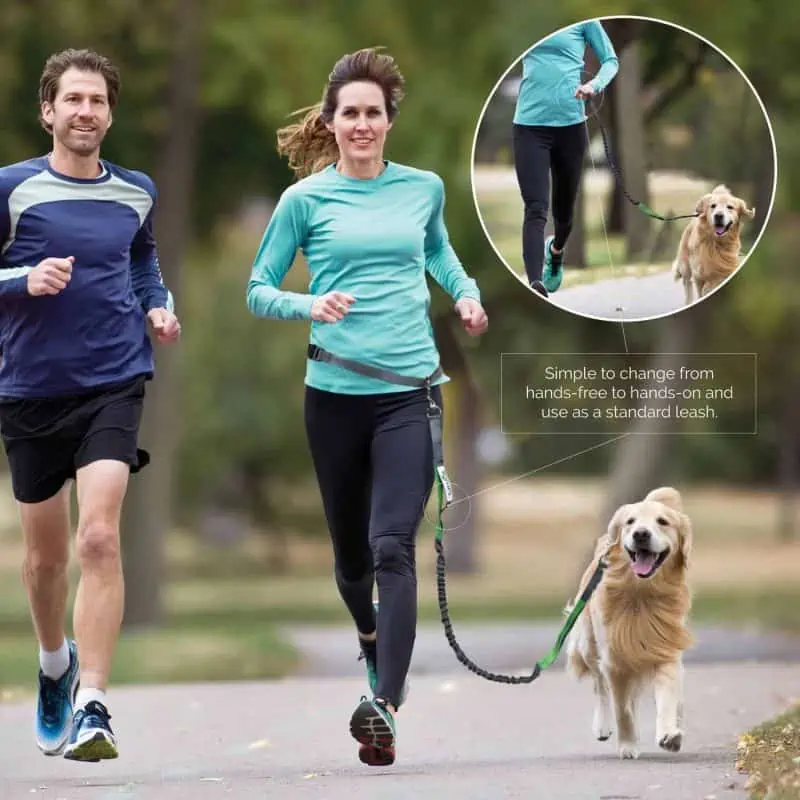How to Train Your Dog to Use a Waist Leash for Walks & Runs
Switching to a hands-free waist leash is one of the smartest moves you can make as a dog owner, especially if you love to walk, run, or hike regularly. But like any new routine, it takes a bit of training and adjustment for your dog to get the hang of it.
The good news? With just a few consistent steps, you can teach your dog to walk calmly and confidently by your side using a waist leash – freeing up your hands and making your outings smoother than ever.
Here’s exactly how to train your dog to use a waist leash.
Step 1: Choose the Right Waist Leash & Get Comfortable With the Gear
First things first – you’ll need to invest in a high-quality waist leash that’s designed for both comfort and control. Things to look for in a quality waist leash include:
- A smooth-glide belt clip so your dog can move naturally side to side
- Shock-absorbing bungee that softens sudden pulls
- Dual padded handles for quick corrections or extra control
- Reflective stitching for added visibility on early morning or evening walks
The Tuff Mutt Hands-Free Waist Leash is a great option that features all of the above options.
Once you’ve got your leash, give your dog time to get familiar with it. Let them sniff the leash and belt, clip it to their harness or collar, and practice walking around your house or backyard. You can even wear the belt indoors so your dog starts to associate it with positive experiences.
Keep these early sessions light, short, and fun. The goal is to get your dog comfortable and curious—not overwhelmed. Use treats and verbal praise to reinforce positive behavior as they explore the new gear.
Step 2: Brush Up on Basic Leash Manners
Before hitting the streets hands-free, make sure your dog has a solid foundation with regular leash walking. If they tend to pull, zigzag, or get distracted easily, take time to work on the basics with a standard 4–6 foot leash.
Some helpful commands to reinforce during this stage include:
- “Heel” – Encourage your dog to walk calmly beside you.
- “Let’s go” – Signal the start of your walk or run.
- “Easy” – Help your dog slow down or stop pulling.
- “Leave it” – Redirect their attention away from distractions.
If your dog already does well on a leash, you’re ahead of the game. If not, invest a few days or weeks to lay that groundwork—it will make the transition to a waist leash much smoother.
Step 3: Start Training in a Low-Distraction Area
Once your dog is familiar with the gear and comfortable walking calmly on a leash, it’s time to start using the waist leash in a quiet, controlled environment like your backyard, driveway, or an empty park path.
Attach the leash to your waist, clip it to your dog’s collar or harness, and walk at a slow, steady pace. Give your dog time to adjust to the feeling of moving alongside you without the leash in your hand.
Here are some training tips to make the process easier:
- Use short, consistent sessions—10–15 minutes is plenty at first
- If your dog pulls ahead, gently guide them back using the hip handle
- Reward calm, steady walking with treats and praise
- Practice turns, stops, and starts to teach your dog to pay attention to your movement
Your goal here is to establish a rhythm and teach your dog that they need to move with you, not ahead of you or all over the place.
Step 4: Add in Light Jogging or Brisk Walking
Once your dog is walking calmly at your side, begin to add a little speed. Start with a brisk walk, then gradually build up to a slow jog.
The key here is to communicate with your dog. Use your voice and movement to signal what’s happening. Phrases like “Let’s go,” “Easy,” or “Slow” can be incredibly helpful for guiding your pace.
The bungee section of your leash will help absorb any sudden pulls, while the smooth-glide clip allows your dog to move naturally without throwing off your balance.
If your dog starts pulling or gets ahead of you, don’t panic—just slow down, redirect them with the hip handle, and resume when they’re back in position. This phase is all about learning to move as a team.
Step 5: Practice in Real-World Scenarios
Once your dog is doing well with jogging or fast walking in low-distraction settings, it’s time to test those skills in the real world. Start by walking or running in quiet neighborhoods, then gradually work up to busier streets, parks, or trails.
Expect occasional setbacks—especially with new distractions like squirrels, other dogs, or loud noises. Use the collar handle for quick corrections if needed, and always keep your tone calm and confident.
Continue using rewards and praise for good behavior, and avoid overcorrecting. If your dog gets overwhelmed, take a break and return to a quieter space. The goal is to build their focus and trust over time—not rush through the process.
Final Thoughts
Training your dog to use a waist leash isn’t just about gear—it’s about connection, teamwork, and communication. With a little patience and the right setup, your walks and runs can become more enjoyable, more freeing, and more aligned with your active lifestyle.
If you’re ready to start your hands-free journey, the Tuff Mutt Hands-Free Waist Leash offers the perfect blend of comfort, durability, and control to make the transition seamless. Once your dog is trained, you’ll wonder how you ever managed with a traditional leash.
So gear up, stay consistent, and enjoy the freedom of moving together—side by side, stride for stride.



